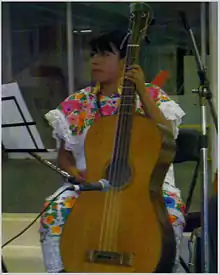Tololoche
The tololoche is a traditional musical instrument from southern Mexico. Its name comes from "tolo loch", from the Mayan language: tolo (bull) and loch (embraced), which would later become tololoche. It is similar to but smaller than the European double bass, and still large enough to produce low-pitched sounds. It has three[1] or four strings, and is plucked with the fingers (pizzicato). It is purely a folk instrument, and not used in classical music.

In northern Mexico it is used in Fara Fara and norteño music. These styles include the accordion, snare drum, tololoche, saxophone, guitar or bajo sexto. It is also used by musicians playing in bars and taverns in northern cities. The tololoche became established in the north of Mexico as indispensable to the interpretation of regional music and less awkward than the classical double-bass to transport.
The instrument is purely acoustic, and its role is endangered by electric instruments such as the electric bass. In the 1950s, modern instruments such as the drum set and the electric bass began to take the place of the tambor de rancho and tololoche, respectively.[2] However, musicians and composers have returned to the tololoche for consistency within the field of traditional music.
Terminology
It is also called chicote because one playing technique produces a whip-like sound. Some players play the chicote note along with two strokes of the palms to produce a drum beat, while others prefer to strike the body as one would the cajón of Peru, creating percussive rhythms when there is no drum available.
Construction
The neck of a tololoche is usually made of pine and the body of caobilla, unlike the viol. The four-string tuning is A-D-G-C (La-Re-Sol-Do), a fourth higher than the double bass. Strings were traditionally made of gut, giving way to nylon and steel-wrapped nylon.
References
- John Mendell Schechter (1999). Music in Latin American culture: regional traditions. Schirmer Books. p. 43. ISBN 978-0-02-864750-0.
- South Texas studies. Victoria College Press. 1997. p. 117.